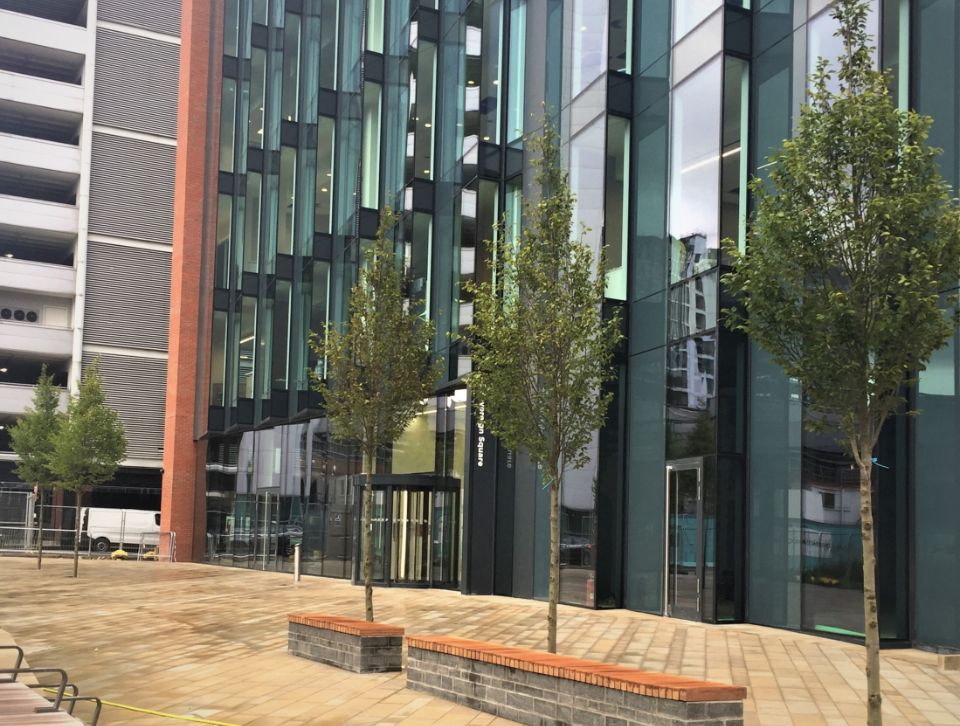The revitalization of Queens Quay, Toronto’s main waterfront street, stretches over 1.7km between Spadina Avenue and Bay Street. Before the recent reconstruction, the street was defined by four lanes of vehicle traffic with narrow sidewalks, and outdated public transit facilities. Dominated by delivery vehicles and used primarily as a loading zone and for the businesses and condominiums that line the street, it acted as a barrier to the City’s waterfront. The revitalization of Queens Quay, which is part of Waterfront Toronto’s redevelopment plan, has been one of the most complex street reconstruction projects in Toronto’s history and has transformed the central waterfront into a vibrant new landmark and destination for the City.
West 8 + DTAH, in joint venture, re-envisioned Queens Quay as a defining landscape that serves as a linear park connecting various parts of the city. A key element of the design is the 232 trees that line the north and south sides of the street and the Martin Goodman Trail, a multi-use recreational trail that is now, for the first time, continuous along the full length of the City’s waterfront.
On the north side of the street, a mix of Maples, Honey locusts, Elms, and Lindens are planted in continuous trenches with 1.2m diameter openings, meeting the city’s standard requirement of 15 cubic meters of soil per tree. The promenade trees on the south side of the street are London Plane trees arranged in two alternating rows with 1.5m diameter openings, planted within wide continuoustrenches. Silva Cells were used to allow the soil volume to span beneath the Martin Goodman Trail and were essential in meeting and exceeding the city’s target soil volume of 30 cubic meters per tree.
Stormwater is also being managed on-site. While the use Silva Cells and the collection of stormwater was initially designed with tree growth in mind, early in the design process the team recognized that the system had the potential to manage stormwater on a broader scale through interception, absorption and evapotranspiration. The design for the irrigation system was fully integrated into the storm system for the street, with input from the City, to ensure that performance and maintenance requirements were met. “The system evolved organically. We put it on the table and got support from the engineers, then the City embraced it and it just came together into something that was much more than what we were originally aiming for. So while the trees were the first imperative – we had a very strong vision for big trees from the start – it was great to be able to bring in the added benefits of low-impact design to the site,” noted Tanya Brown, Project Manager for West 8 + DTAH.

The existing storm system on the street was surcharged and over-capacity, and the new integrated system showed important positive impacts on the overall stormwater calculations for the site. Surface runoff flowing from the Martin Goodman Trail and boulevard surfaces enters the system via custom- designed catch basins that capture, store the first flush of runoff, and allow stormwater to enter the Silva Cells through a network of perforated pipes that passively irrigate the trees. In total, 47 percent of surface runoff is being diverted into the Cells; the entire system was designed to handle a 100-year rain event.
In addition to the low-impact features of the site, landscape materials were selected to be sustainable, robust, durable, and timeless. The granite cobbles that pave the street with a maple leaf mosaic hail from Quebec, and the yellow Cedar for the custom wood street light poles is harvested sustainably in British Columbia. Wood benches line the promenade and add a splash of colour with their bright red cast aluminum supports that also sport the abstracted maple leaf. The project as a whole comes together as a street that welcomes not only residents of the City, but visitors from around the country and the world.
The new design is extremely people-centric. “In a sense, I look at this street as a long public square,” said Michael James of DeepRoot Canada Corp., which supplied the Silva Cells. “It has all the amenities of a central, public square: transit, places to sit and eat and shop, places where things slow down and become pedestrian in scale. That is the environment that West 8 + DTAH created, just in a linear fashion along the whole south side of the street. It’s much easier to connect to and enjoy the waterfront.”
Installation Summary
Average soil volume per tree: 15 m3 (533 ft3)
Number of Trees: 134 (in Silva Cells)
Tree Species: Maple, Honey locust, Elm, Linden, London Plane
Total Silva Cells: 10,800 frames, 5,400 decks
Installation Date: Spring 2014
Installation type: Integrated – Trees and Stormwater
Project Site: Streetscape
Project Designer: West 8 + DTAH
Contractors: Eastern Construction, Aldershot
